Melon Prosciutto Skewers
Skewers...With Melon and Prosciutto
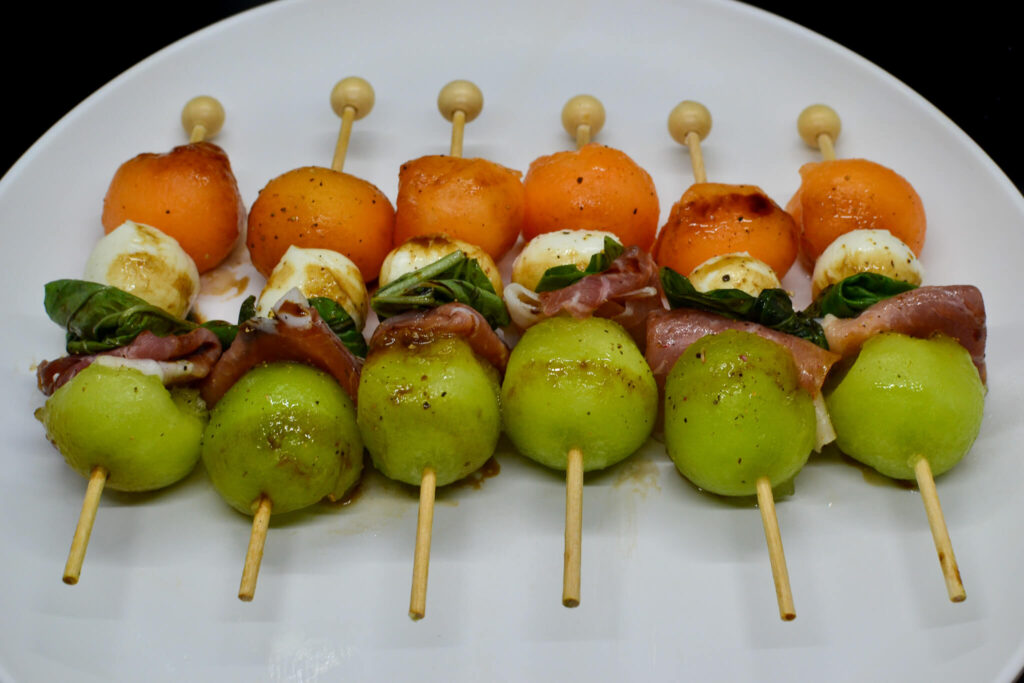
What Are Melon Prosciutto Skewers?
Melon Prosciutto Skewers are a simple and elegant appetizer that combines sweet melon with salty prosciutto. They are typically made by skewering together pieces of melon and slices of prosciutto, often with a fresh herb or cheese for extra flavor.
Ingredients For Melon Prosciutto Skewers
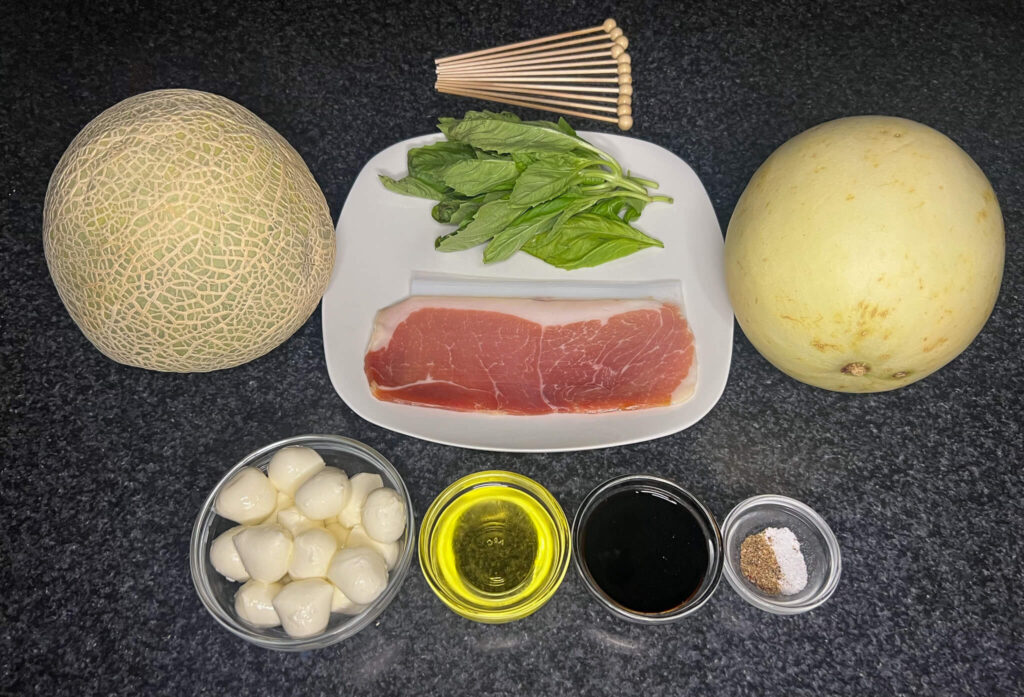

Produce
1 Cantaloupe
1 Honey Dew
Fresh Basil Leaves
Refrigerated
8 oz Mozzarella Balls
Olive Oil

Grocery
Skewers
Balsamic Glaze

Meat
3 oz Prosciutto

Spices
1/2 Tsp Salt
1/2 Tsp Black Pepper
How To Make Melon Prosciutto Skewers
Step 1
Slice/Scoop Honey Dew & Cantaloupe
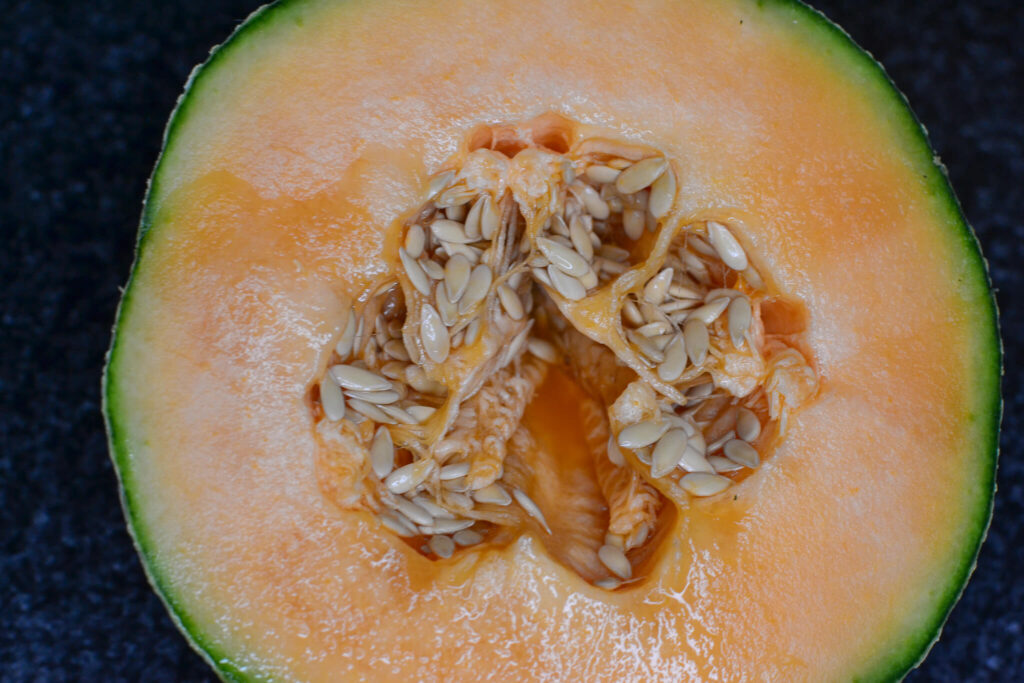
Start making your dish by picking and getting ready the honeydew and cantaloupe. These fruits are important for your recipe because they have different tastes and textures. To choose the best ones, look for melons that are heavy for their size and have a light sweet smell, showing they are ripe.
This step is quite similar to scooping out the seeds from a butternut squash, a technique also used in preparing the Butternut Squash and Apple Casserole.
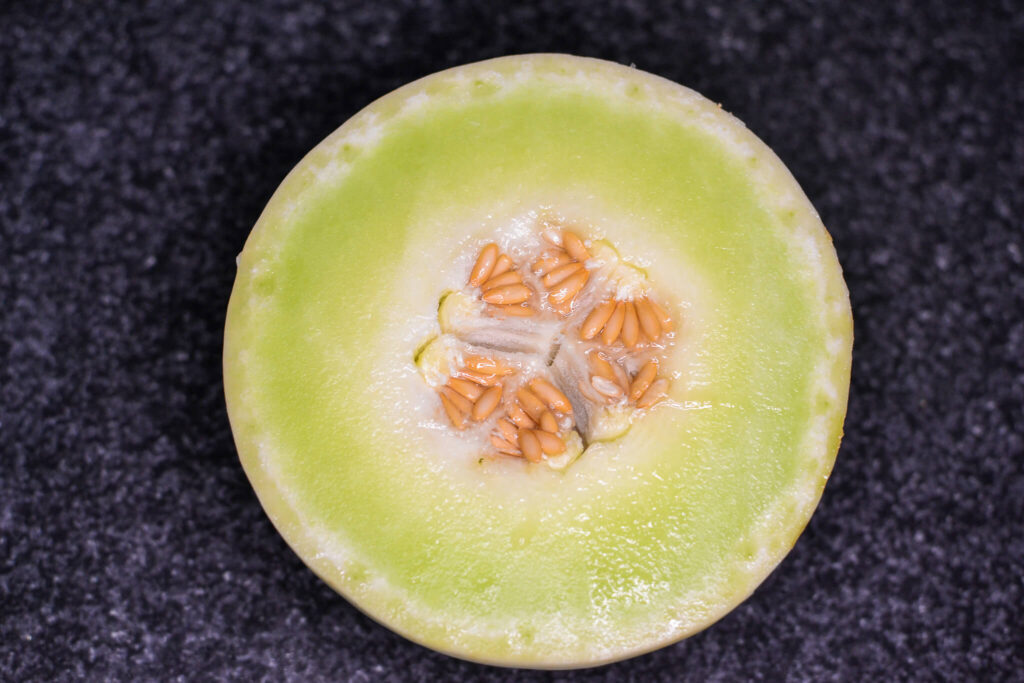
After choosing your cantaloupe, turn to the honeydew. Like the cantaloupe, a good honeydew will smell a bit sweet and feel slightly soft when you press it.
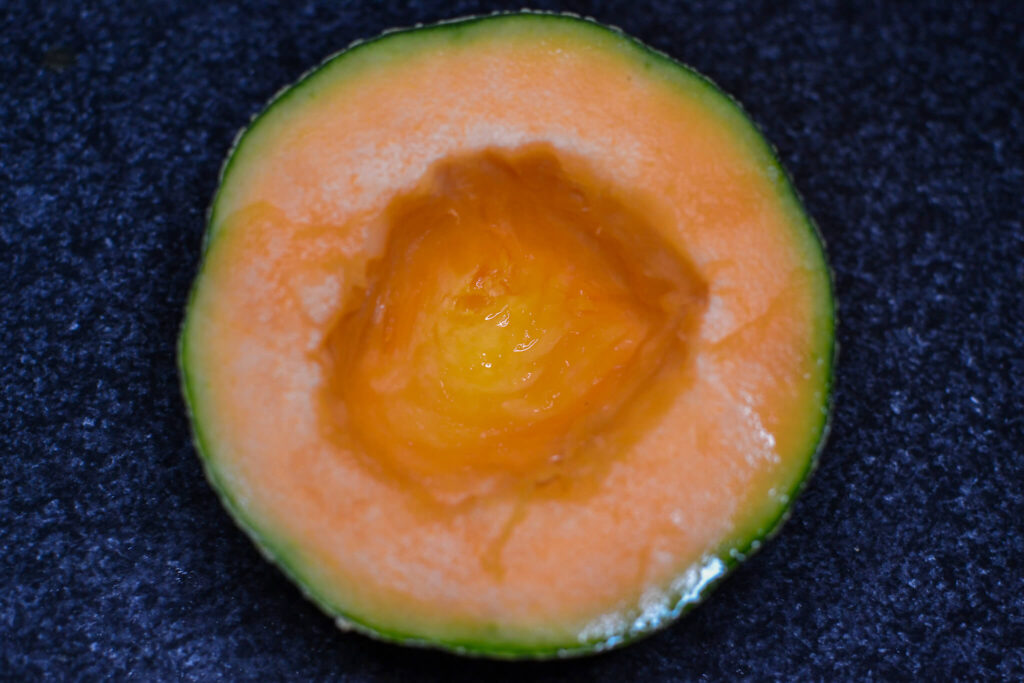
Clean the melons and then cut them in half. This shows their bright colors and fresh smells. Inside, you’ll find the seeds, which you can easily remove with a spoon.
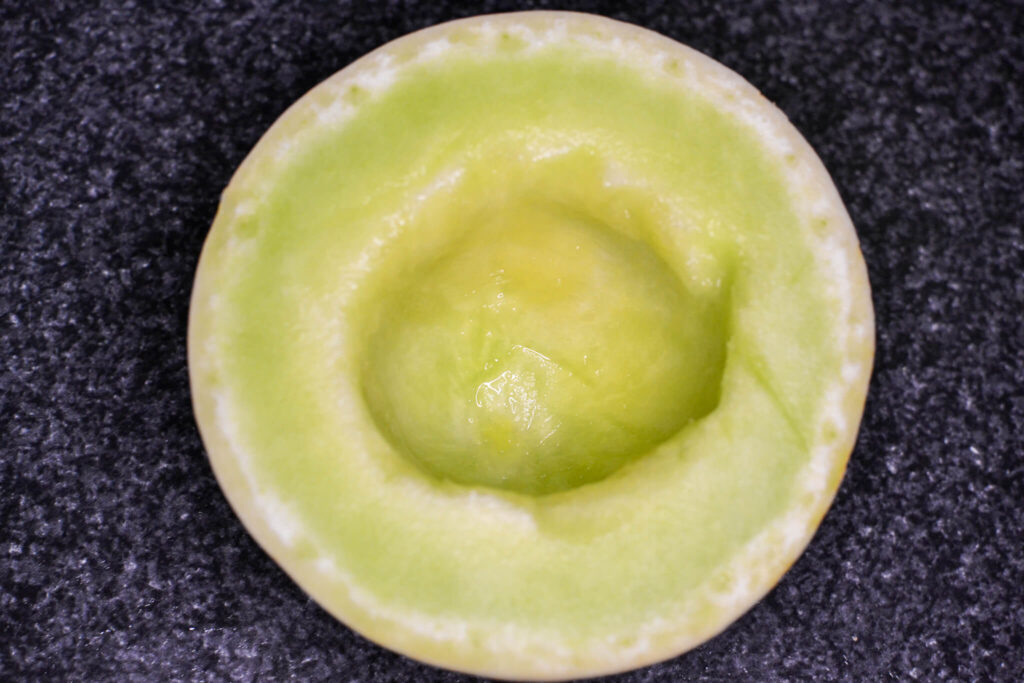
Do the same with the honeydew: take out the seeds and show the ripe fruit inside. This step is more than just seed removal; it’s about revealing the real flavor of the fruits, getting them ready for the next part of your recipe.
Step 2
Mellon Ball Away!
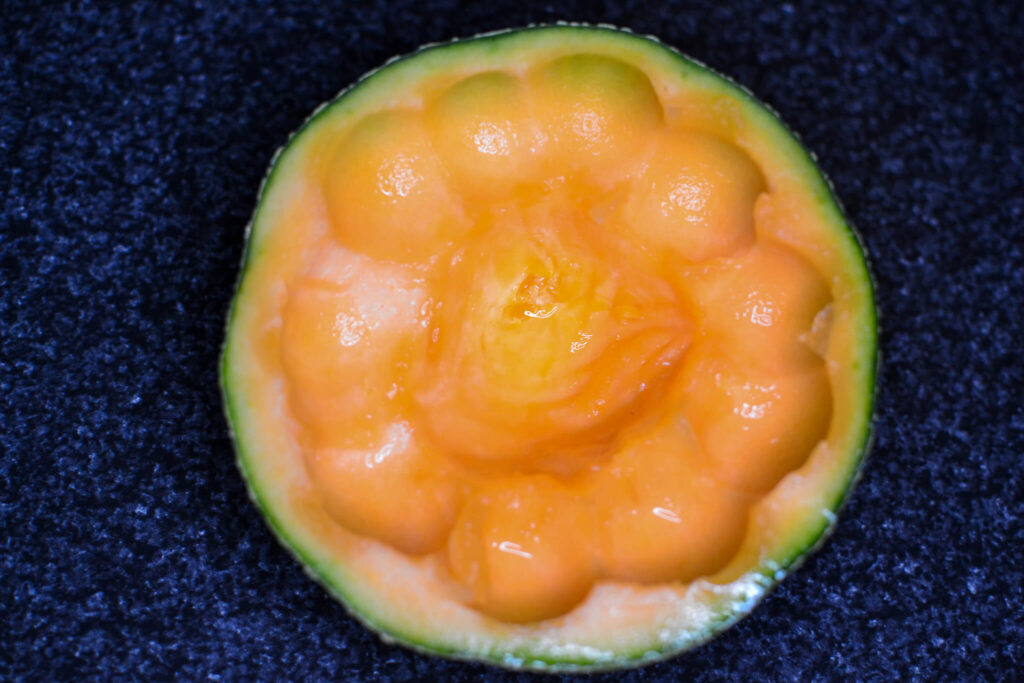
With your ready honeydew and cantaloupe, it’s now time to make attractive, small spheres. Melon balling is a skillful mix of accuracy and creativity. Use a melon baller scoop to carefully shape the flesh of both fruits into balls. This process not only creates a visually appealing presentation but also offers a delightful way to enjoy the melons. The melon baller scoop is perfect for this task, allowing you to extract the ripe fruit in uniform, bite-sized portions. As you work, you’ll see the vibrant colors and feel the fresh texture of the melons, preparing them for their role in melon skewers.
You can buy a melon baller here.
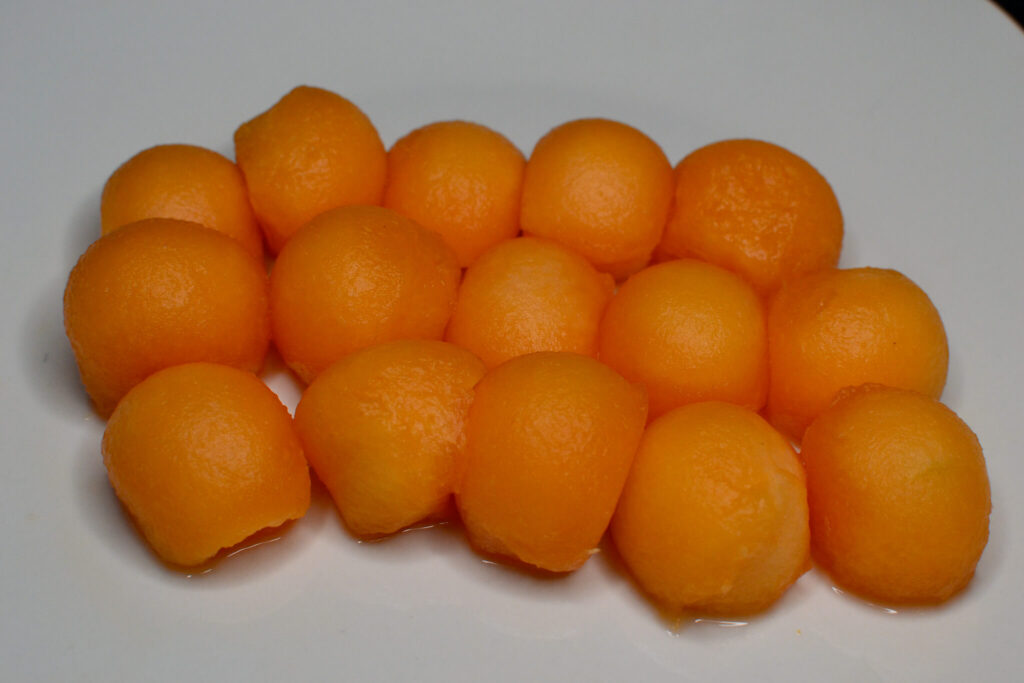
Every scoop turns the bright orange cantaloupe into perfect, juicy spheres. These spheres look lively and summery, making your dish look good and taste sweet and fresh.
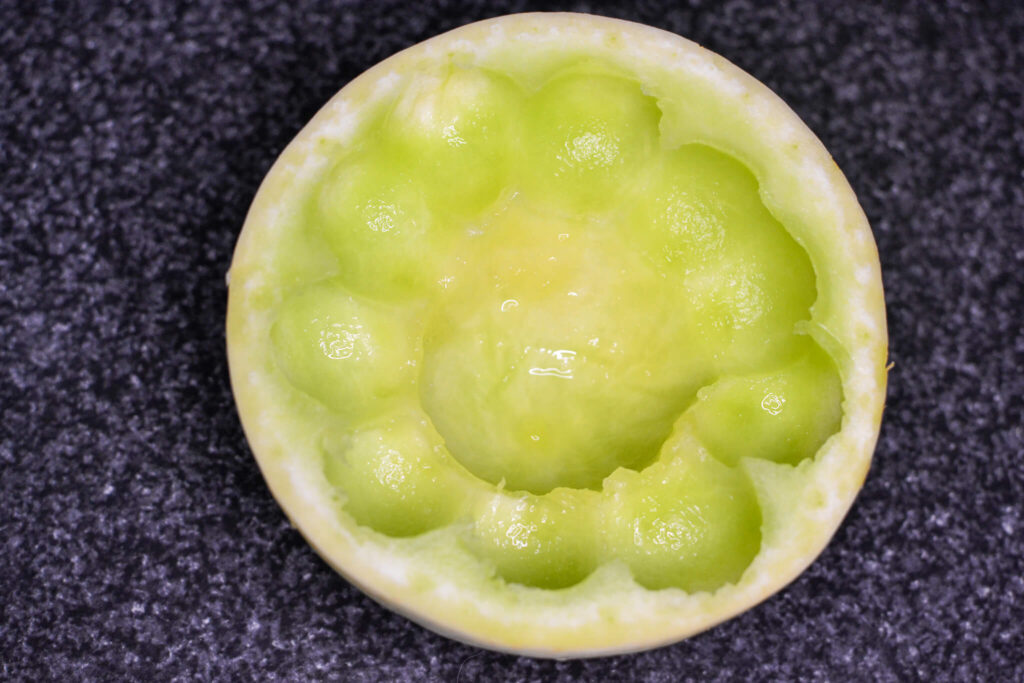
On the other hand, the pale green honeydew melon balls add a gentle and stylish difference. They have a softer, lighter taste that nicely balances the stronger sweetness of the cantaloupe.
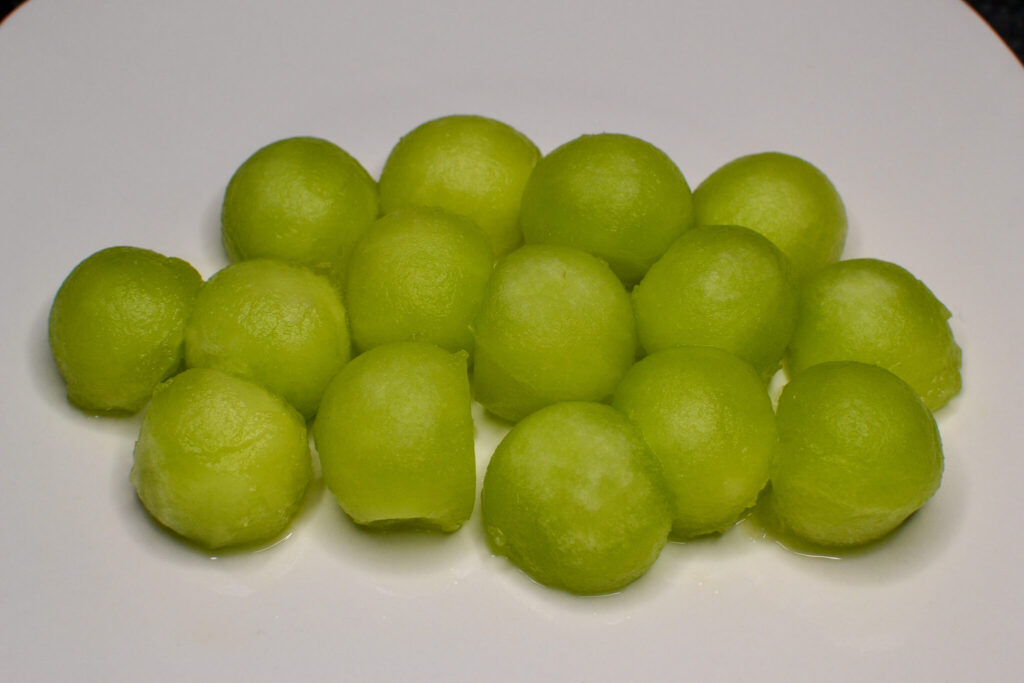
This part of getting ready is really nice to look at. The melon balls, now set out on plates, are more than just parts of the recipe; they are the main attraction, ready to be combined with the savory pieces of your skewers.
Step 3
Slice Prosciutto
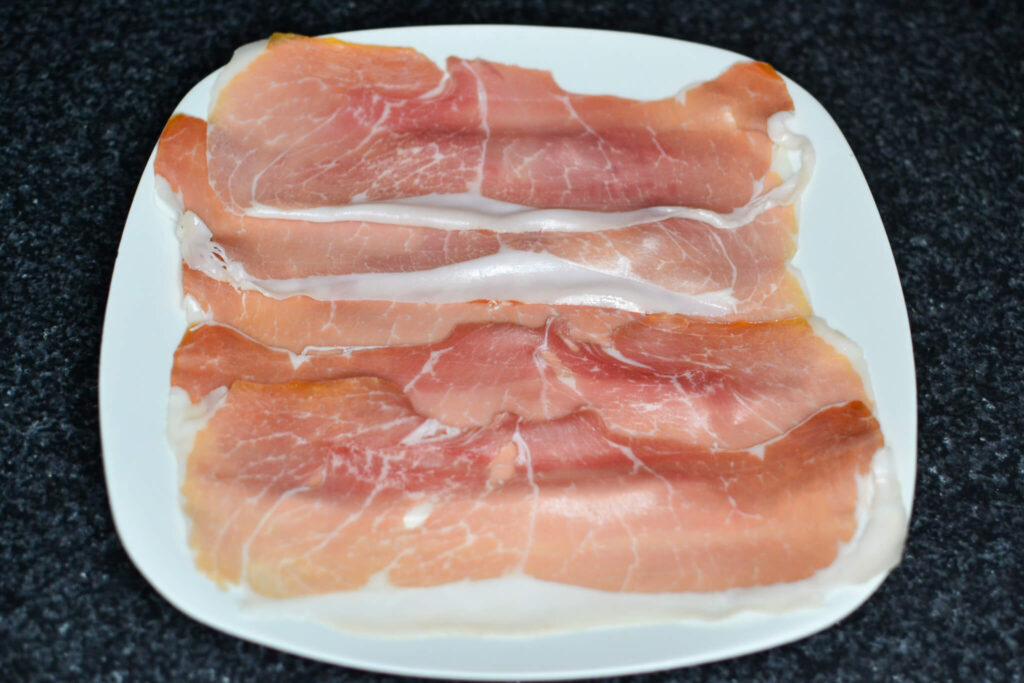
Prosciutto brings a special touch to your skewers with its fine texture and deep savory taste. Spread out the whole prosciutto and take in its smell, feel, and deep color, all signs of the rich flavors it will add to your dish. As you pair the prosciutto with the melon balls, the contrast of the salty, savory prosciutto and the sweet, juicy fruit creates a delightful combination. This classic pairing of prosciutto and melon is not just a feast for the taste buds but also for the eyes. The thin slices of prosciutto wrapped around the colorful melon spheres offer a gourmet experience, blending textures and flavors in a way that enhances the overall appeal of your skewers.
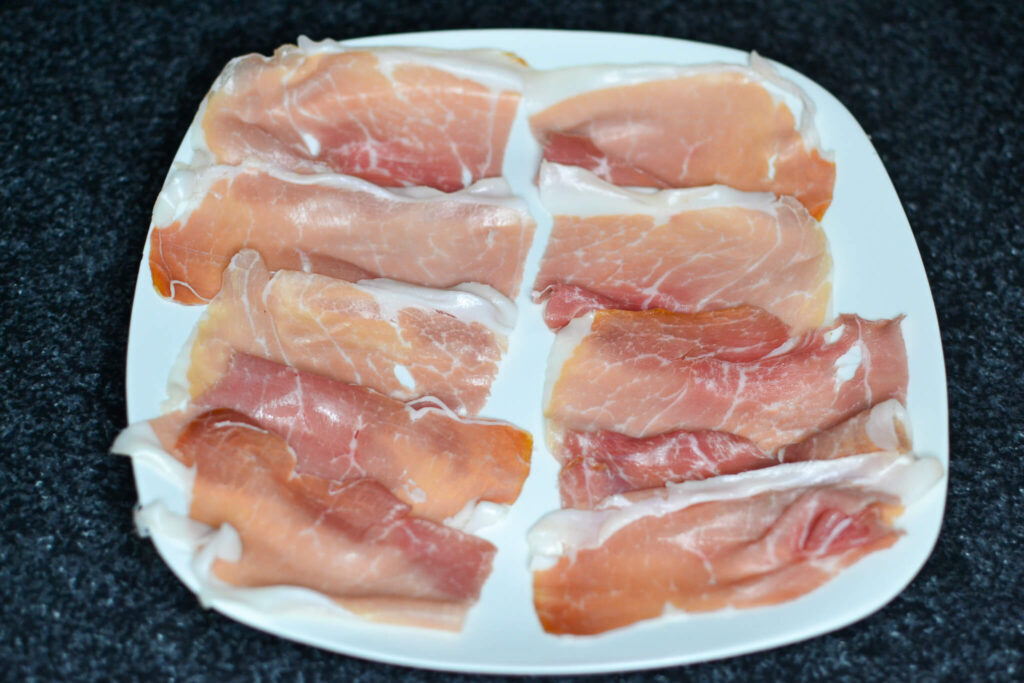
Slice the prosciutto into thin strips, making sure to keep them light and intact. This step is about cutting the meat in a way that works well with the melon balls, helping to create a good mix of flavors for your skewers.
Step 4
Assemble Skewer
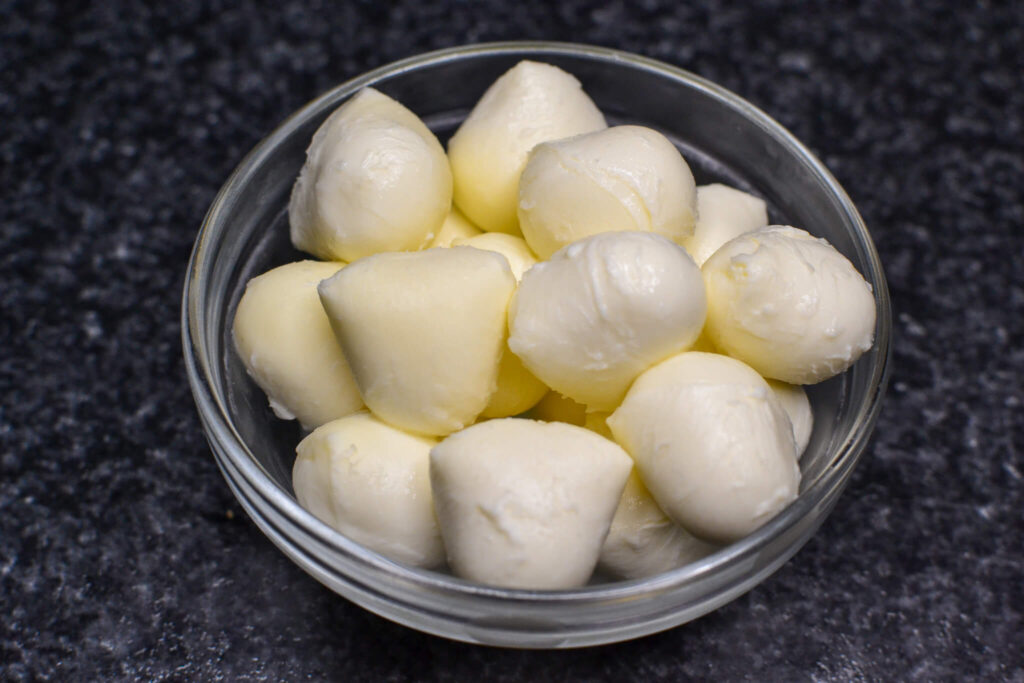
Putting together the skewers is a fun, creative part. Start with your basil leaves and small fresh mozzarella balls, about the size of cherries, to make it easy to assemble. These mozzarella balls are perfect for skewers because they’re just the right size for a bite. Adding them with the basil, and later with a balsamic glaze, creates a delicious mix of flavors.
Using Bel Gioioso Mozzarella Balls in your skewers is a great choice because they’re known for their quality and taste. These mozzarella balls are made with fresh ingredients, giving them a soft, creamy texture and a mild, milky flavor. This makes them ideal for skewers, as they pair well with the other flavors, like the sweet melon and savory prosciutto, without overpowering them. Plus, their convenient, bite-sized shape makes assembling your skewers easier and adds to the visual appeal of your dish.
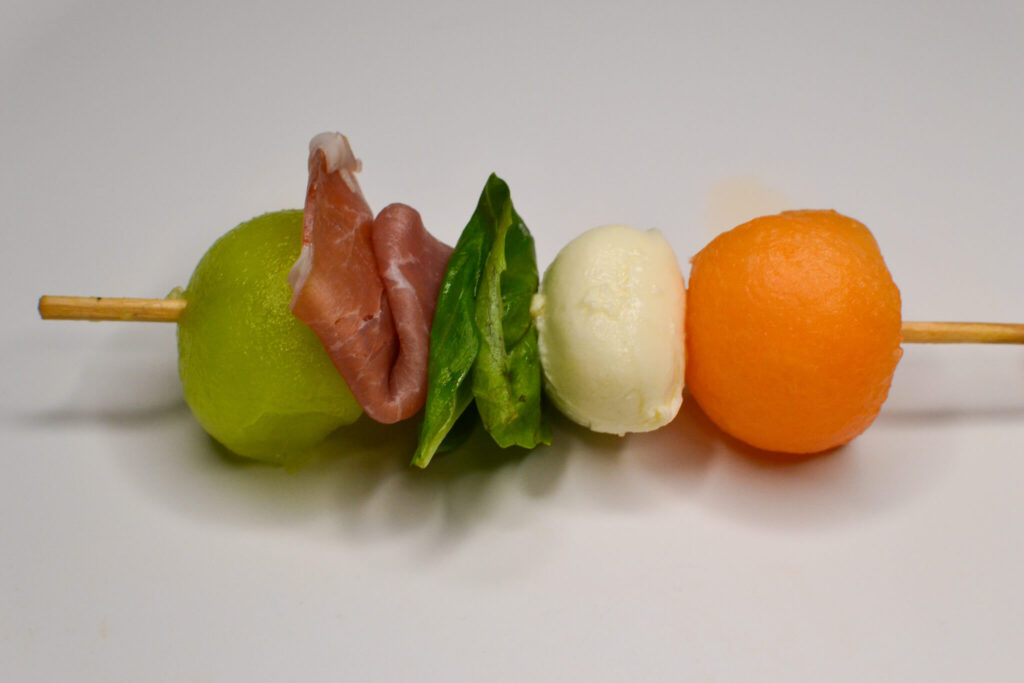
When you start assembling your skewers, begin with a piece of cantaloupe. After that, add a mozzarella ball, followed by a basil leaf, then a strip of prosciutto, and finish with another piece of cantaloupe. This order gives you a mix of sweet, creamy, herby, and savory flavors in every skewer, making each bite delicious and balanced. The cantaloupe at both ends also helps to hold everything together neatly.
I also used rock candy sticks, because why not?
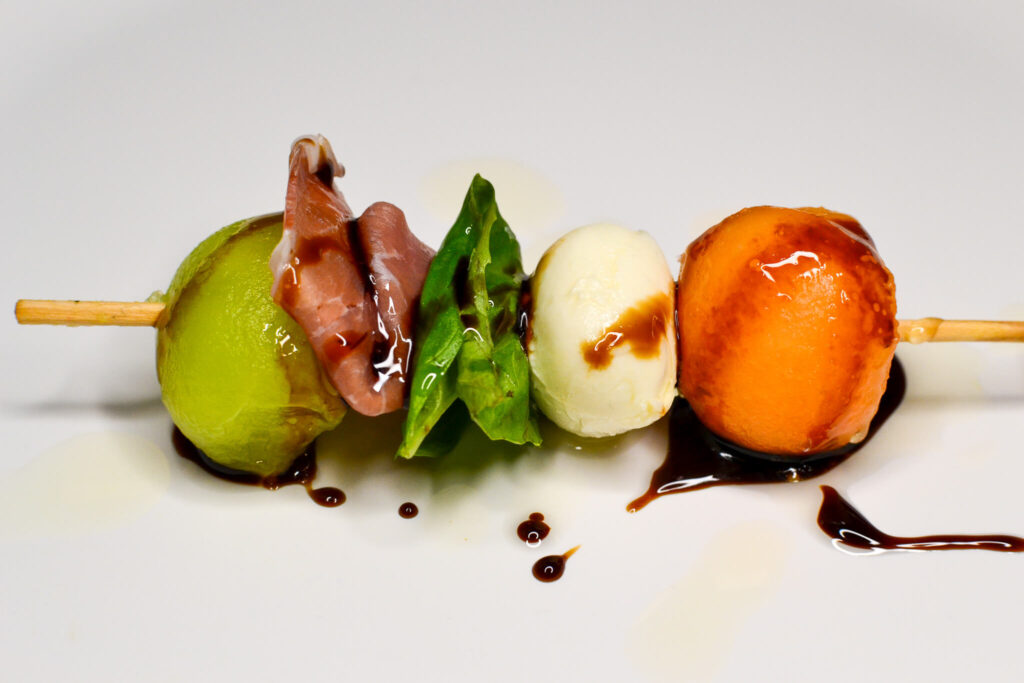
Now, it’s time to finish up your skewers. Pour a bit of olive oil and balsamic glaze over the skewers. The olive oil adds a smooth texture, while the balsamic glaze brings a tangy sweetness. Together, they enhance the flavors of the melon and prosciutto, making your skewers even tastier.
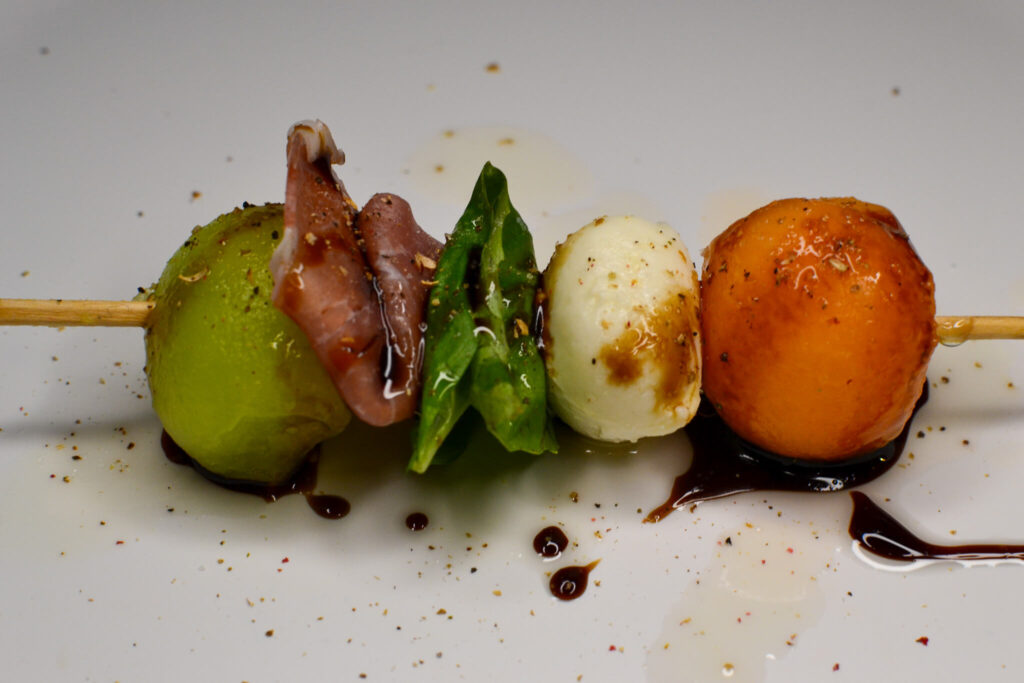
Sprinkle some salt and pepper over the skewers. This easy step enhances the flavors, bringing together the sweet, salty, and tangy tastes in every bite. It makes the sweet melon and savory prosciutto even more delicious.
Step 5
Enjoy Your Melon Prosciutto Skewers!

Arrange your skewers on a serving platter and cover them with plastic wrap. This not only keeps them fresh but also presents a dish that’s both delicious and a visually appealing showcase of summer’s best flavors. The plastic wrap ensures the flavors are preserved, highlighting your attention to detail and creativity in their preparation.
Enjoy!

Severance

Inspiration
The Melon Bar

More About Melon Prosciutto Skewers
The origin of this dish combines elements from Italian and broader Mediterranean culinary traditions. Let’s break down the components and their origins:
- Prosciutto: Prosciutto, specifically Prosciutto di Parma, is a dry-cured ham that originated in the Parma region of Italy. This delicacy, known for its delicate texture and savory taste, has been a staple in Italian cuisine for centuries. Its production method, which involves curing the ham with salt and aging it for months or even years, dates back to pre-Roman times.
- Melon: The pairing of melon with prosciutto is a classic in Italian cuisine. Melons, including cantaloupe and honeydew, have been cultivated in the Mediterranean region for thousands of years. The combination of melon’s sweet and refreshing taste with the salty richness of prosciutto creates a perfect balance of flavors.
- Mozzarella Cheese: Mozzarella is a traditionally southern Italian cheese made from Italian buffalo’s milk by the pasta filata method. It’s known for its delicate, milky flavor and soft, stretchy texture. Mozzarella cheese originated in the Campania region of Italy, particularly in and around Naples. Its introduction to the wider Italian culinary tradition added a creamy, mild element that pairs well with both savory and sweet ingredients.
- Basil: Basil, particularly sweet basil, is a staple herb in Italian cuisine. It is native to tropical regions from Central Africa to Southeast Asia, but it has been a key ingredient in Mediterranean cooking for centuries. Basil adds a fresh, aromatic, and slightly sweet flavor to dishes. In Italian cuisine, it’s often used in combination with tomato-based dishes, but its fresh, peppery flavor also complements the sweet and savory flavors.
- Skewers: The concept of skewering food items is ancient and widespread, found in many cultures around the world. It’s more about a modern, convenient way of serving and a visually appealing presentation rather than being rooted in deep historical origins.
The dish as a whole reflects the Italian ethos of using high-quality, fresh ingredients and combining them in simple yet delicious ways. It’s a popular choice in the summer months, showcasing the season’s ripe melons. The idea of skewering these ingredients together is more of a contemporary twist, likely developed for ease of eating and aesthetic presentation, especially for parties or gatherings. This dish exemplifies the Mediterranean and Italian culinary principle of harmonizing contrasting flavors and textures – the sweet, juicy melon with the salty, rich prosciutto. While the exact origin of combining these specific ingredients on a skewer isn’t clear, it’s a modern take on a classic flavor pairing.
Cantaloupe and honeydew melons are not only delicious but also offer several health benefits:
- Nutrient-Rich: Both cantaloupe and honeydew are rich in essential nutrients. Cantaloupe is a great source of vitamins A and C, which are vital for skin health and immune function. Honeydew also provides a good amount of vitamin C, along with potassium, which is important for heart health and blood pressure regulation.
- Hydration: These melons have high water content, making them excellent for hydration. Eating them can help you stay hydrated, especially in hot weather or after exercise.
- Low in Calories: Both fruits are low in calories, making them a healthy choice for those monitoring their calorie intake.
- Dietary Fiber: They contain dietary fiber, which is beneficial for digestive health. Fiber helps in regular bowel movements and can aid in preventing constipation.
- Antioxidants: They are rich in antioxidants, which help combat oxidative stress in the body. This is important for reducing the risk of chronic diseases and maintaining overall health.
- Eye Health: The beta-carotene in cantaloupe is particularly beneficial for eye health. It helps prevent age-related macular degeneration and other eye conditions.
- Heart Health: The potassium in honeydew can help lower blood pressure and reduce the risk of heart disease.
- Weight Management: Due to their high water and fiber content, these melons can help you feel full, potentially aiding in weight management.
Incorporating cantaloupe and honeydew into your diet can be a delicious way to enjoy these health benefits. However, it’s always good to consume them as part of a balanced diet.

